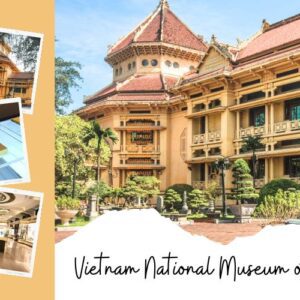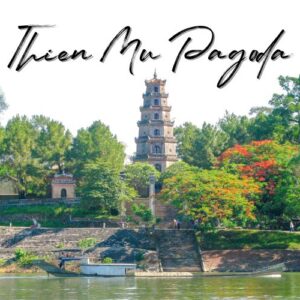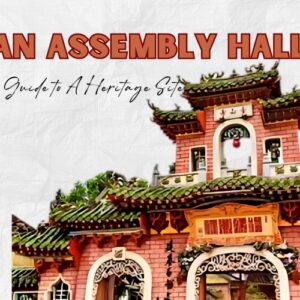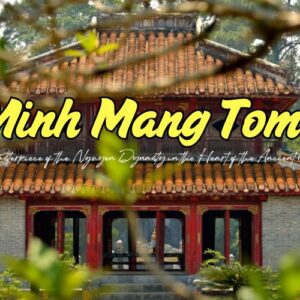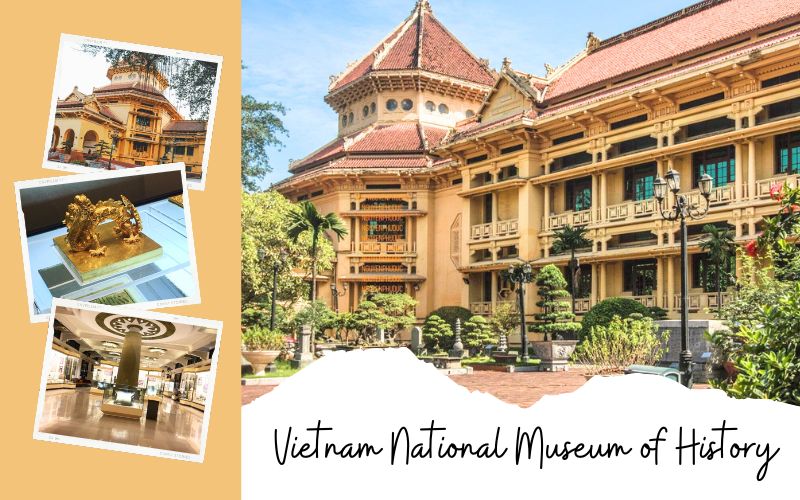
Vietnam National Museum of History, located in Hanoi, is indeed a must-visit destination for history and culture enthusiasts. The museum provides a comprehensive overview of Vietnam’s history and presents the country’s rich cultural heritage through its diverse collection of relics, exhibitions, and displays. Visitors to the museum have the opportunity to delve into Vietnam’s extensive history, starting from prehistoric times and continuing through the various periods, such as the ancient Vietnamese kingdoms, the Chinese domination, the French colonial era, and the more recent struggles for independence and reunification. When you are traveling to Hanoi, don’t forget to visit this signification destination.
Essential Information for Tourists
Location of Vietnam National Museum of History
- Facility 1: Located at 1 Trang Tien, Phan Chu Trinh Ward, Hoan Kiem District, Hanoi City.
- Facility 2: Situated at 216 Tran Quang Khai, Trang Tien Ward, Hoan Kiem District, Hanoi City.
Opening hours and Entrance fees
Opening hours: The museum operates from 8 AM to 12 PM and from 1:30 PM to 5 PM every day, except on the first Monday of the month.
Entrance fees:
- Adults: The ticket price for adults is 40,000 Vietnamese Dong, which is approximately 1.7 USD.
- College/University students: The ticket price for college/university students is 20,000 Vietnamese Dong, approximately 0.9 USD.
- High school students: The ticket price for high school students is 10,000 Vietnamese Dong, approximately 0.4 USD.
- Children under 6 years of age and disabled individuals: Entry is free of charge for children under 6 years of age and disabled individuals.
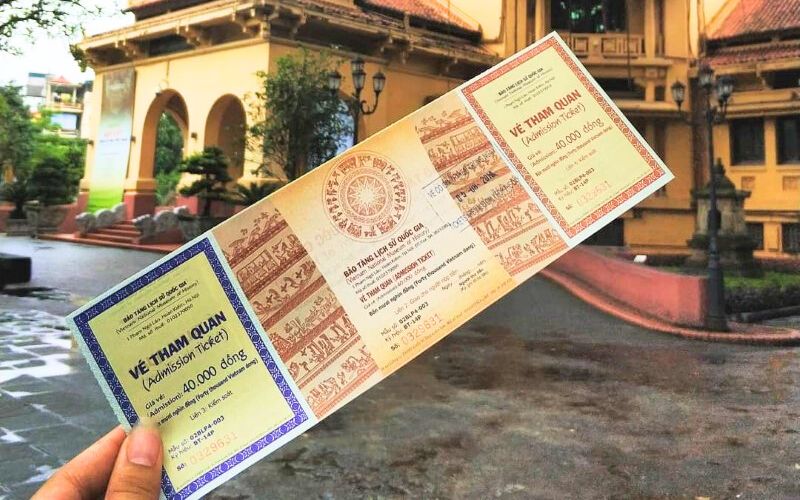
Entrance ticket
Ticket prices for photography:
- Pictures: 15,000 Vietnamese Dong (VND)/camera/ticket.
- Filming: 30,000 VND/camera/ticket.
Regulations of the museum
At the Vietnam National Museum of History, you have the option of guided tours in Vietnamese, English, and French languages. To request a tour guide, you can contact the information room located next to the entrance.
Here are some important reminders for your visit:
- Remember to present your ticket at Counter One, which is located next to the gallery entrance.
- Prohibited to bring weapons, flammables, explosives, poisons, or any hazardous materials inside the museum.
- Store your luggage in the museum’s locker.
- Don’t smoke or eat within the museum premises.
- Don’t touch the exhibits and equipment to preserve their integrity and prevent damage.
- Kindly maintain a peaceful and quiet environment inside the museum, refraining from making excessive noise that may disturb others.
The Museum’s History
The precursor to the current building was the Louis Finot Museum, a project initiated by the Institute of the École Française d’Extrême-Orient, a French research center for Orientalism in Indochina. Established in 1900 in Saigon, it was later relocated to Hanoi in 1902. The construction of the building took place between 1926 and 1932 and was named after its first director, Louis Finot (1864-1935).
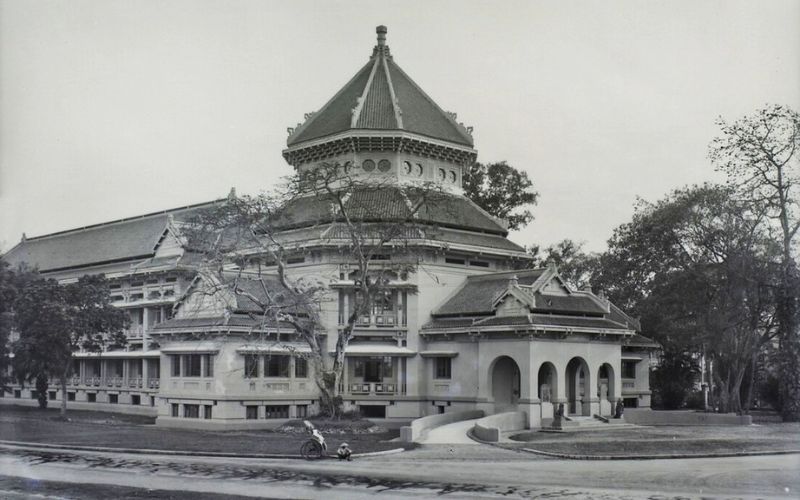
Louis Finot Museum, the precursor National Museum of Vietnamese History
The Vietnam History Museum in Hanoi was established on September 3, 1958, building upon the legacy of the Louis Finot Museum. It stands as a unique architectural masterpiece, exemplifying the distinct Indochinese architectural style prevalent in Hanoi. The museum comprises two separate exhibition spaces: one located on Tran Quang Khai Street and the other on Trang Tien Street. These two buildings, constructed in 1917 and 1926 respectively, are among the oldest architectural structures in Hanoi and represent the oldest museums in the city.
The Signification of the Vietnam National Museum of History
Since its establishment in 1910, the Vietnam National Museum of History has played an important role in maintaining the cultural and historical heritage of the nation. The museum was originally a part of the École Française d’Extrême-Orient, then it changed its name to the Vietnam National Museum of History after the founding of the Democratic Republic of Vietnam in 1945.
At present, the Vietnam National Museum of History houses a vast collection of over 20,000 documents and artifacts that chronicle the entire historical trajectory of Vietnam, spanning from ancient times to the present. Coming here, you can admire ancient bronze drums, iconic stone steles from the Nguyen dynasty, and a wealth of other historically significant items. In addition, the museum highlights the cultural and ethnic diversity of Vietnam, featuring exhibitions on the Cham culture and the country’s ethnic minorities. This extensive collection contributes to the museum’s well-deserved reputation as the premier museum in Hanoi. One notable aspect is the incorporation of technology in the museum’s exhibits and educational programs, making it a pioneer in Vietnam. The National Museum of History’s website now offers a 3D virtual interactive tour, providing an immersive experience to explore the entire collection without the need for a physical visit.
In recent years, the establishment of the National Museum of Vietnamese History has facilitated enhanced international cooperation in various areas. Notably, there has been fruitful collaboration in the fields of exchange, exhibition, and research on archaeological excavations, creating opportunities for broader cooperation. As a result of its role, functions, and inherent advantages, the National Museum of Vietnamese History has become a popular and cherished destination for both domestic and foreign tourists. By attracting visitors from different parts of the world, the museum contributes to the socio-economic development of the country.
The Museum’s Unique Architecture
The National Museum of History’s enchanting architecture is a perfect blend between innovation and distinctive Eastern culture, which makes it an exceptional destination. It captivates the hearts of many beauty enthusiasts at first sight.
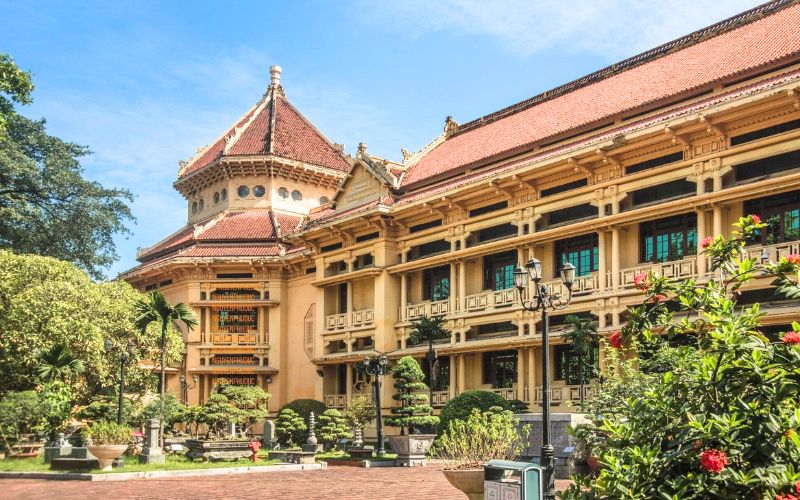
The overall special architecture of the museum
The design of the museum grounds prioritizes spaciousness, as they were purposefully constructed to accommodate exhibition areas. The primary display space is located directly behind the long rectangular hall, while themed exhibition areas are spread out on both ends, providing ample presentation room. Although the octagonal shape bears a resemblance to ancient Chinese architecture, skillful architects have masterfully crafted the entire roof structure to resemble the bell tower of Keo Pagoda in Thai Binh. The exhibition spaces boast a complete roofing system designed with double-layered, traditional Vietnamese temple-style roofs, commonly seen in historical places of worship.
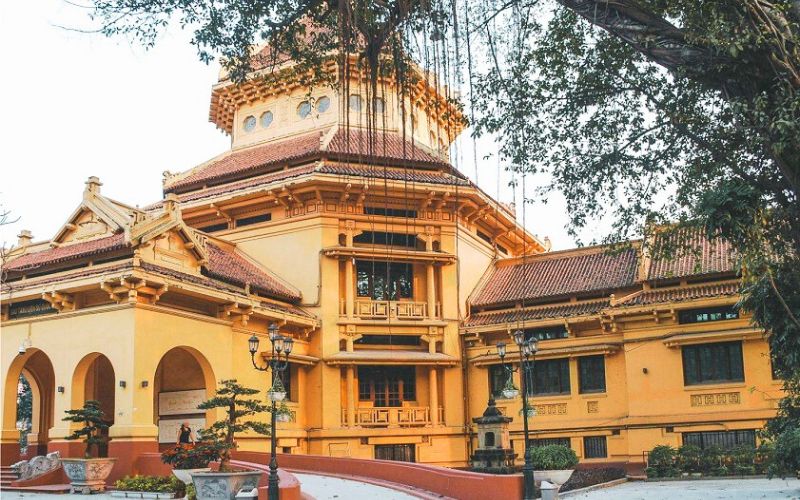
The entrance of Vietnam National Museum of History
The Vietnam National Museum of History building is a testament to the integration of Asian and European influences within its structural design, as well as its seamless integration with the surrounding environment. It stands as a remarkable example of the Indochinese architectural style and is deserving of recognition as an esteemed architectural masterpiece.
Famous Exhibitions of Vietnam National Museum of History
Vietnam National Museum of History in Hanoi encompasses two distinct exhibition areas. The first exhibition area, located at No. 1 Trang Tien Street, focuses on Vietnam’s history from prehistoric times to the conclusion of the Nguyen Dynasty (1802-1945). The second exhibition area, located at 216 Tran Quang Khai Street, explores Vietnam’s history from the mid-19th century to the present day. These two exhibition spaces provide visitors with a comprehensive journey through Vietnam’s rich historical and cultural heritage.
At No. 1 Trang Tien Street
The museum at No 1 Trang Tien offers a comprehensive display of Vietnam’s extensive history, starting from the early presence of humans in the region to the nation’s development through the establishment of its earliest foundations, the enduring struggle for independence, and the gradual accumulation of a rich cultural heritage across feudal dynasties.
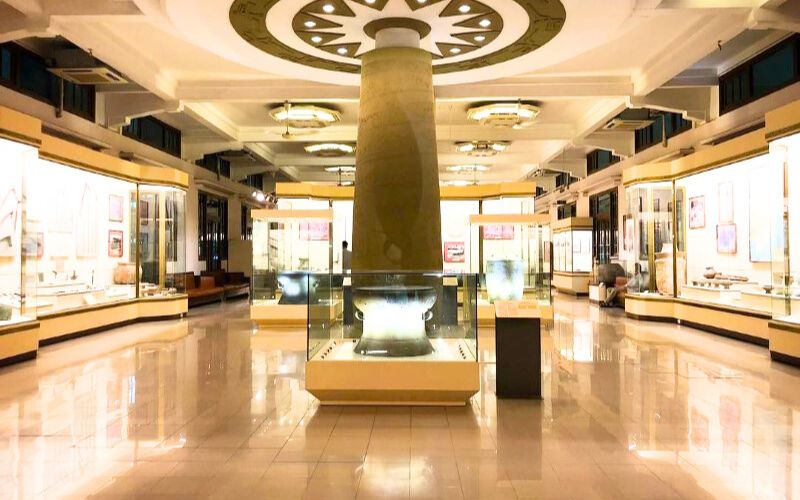
The museum at No 1 Trang Tien Street
In addition to its historical narrative, the museum showcases outstanding collections such as the Oc Eo-Phu Nam cultural relics, Champa sculptures, and artworks created by students of the Indochina Fine Arts during the French colonial period. The outdoor display area adds to the museum’s allure, providing an opportunity to explore the vibrant Champa culture through a diverse collection of artifacts and sculptures. Furthermore, you can encounter grand inscriptions, statues, and worship towers from the Ly and Nguyen dynasties, providing insights into their respective artistic and religious contributions.
At No. 216 Tran Quang Khai Street
When coming to the museum at 216 Tran Quang Khai, you can witness heroic collections in Vietnam’s history, covering the period from 1858 when the French began their invasion of Vietnam to the conclusion of the Vietnam War in 1975, with the intervention of the United States. This permanent exhibition delves into the struggles and heroism of the Vietnamese people during this tumultuous time, showcasing their resilience, dedication, and efforts to fight, work, and rebuild amidst war, as well as their preparations for the country’s development in the aftermath of the conflict.
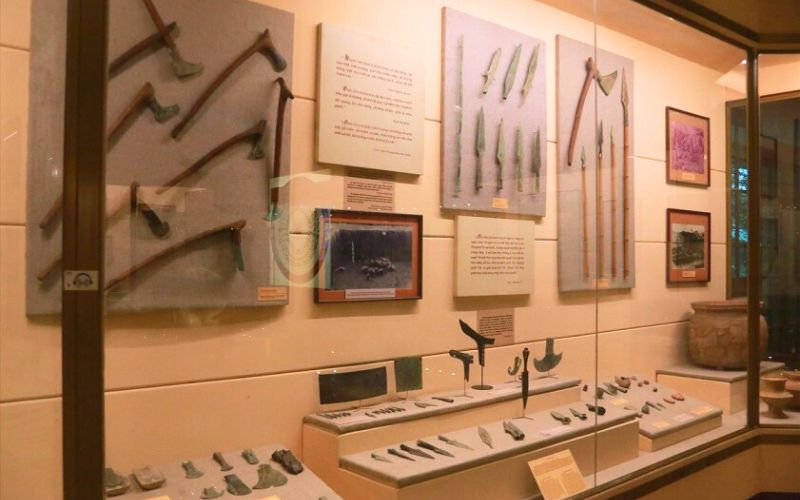
The museum at No 216 Trang Quang Khai
Within this exhibition, visitors will encounter over 100 original artifacts that were gifted to President Ho Chi Minh and the Vietnamese Communist Party by local and international individuals. These artifacts serve as testaments to the support and solidarity shown to Vietnam during its historic struggles. Furthermore, the front and backyard areas of the National Museum of History feature several large-scale objects with significant historical value. One notable highlight is the car presented to the Communist Party of Vietnam by the Communist Party of the Soviet Union in 1954, symbolizing the enduring camaraderie and support between the two nations.
Places to Visit near Vietnam National Museum of History
Hanoi Opera House
Hanoi Opera House, situated in close proximity to the Vietnam National Museum of History and near Hoan Kiem Lake, is a must-visit destination for tourists exploring Hanoi. Constructed in 1911 with a distinct French architectural style, the Hanoi Opera House remains the largest opera house in Vietnam and holds significant cultural and historical value.
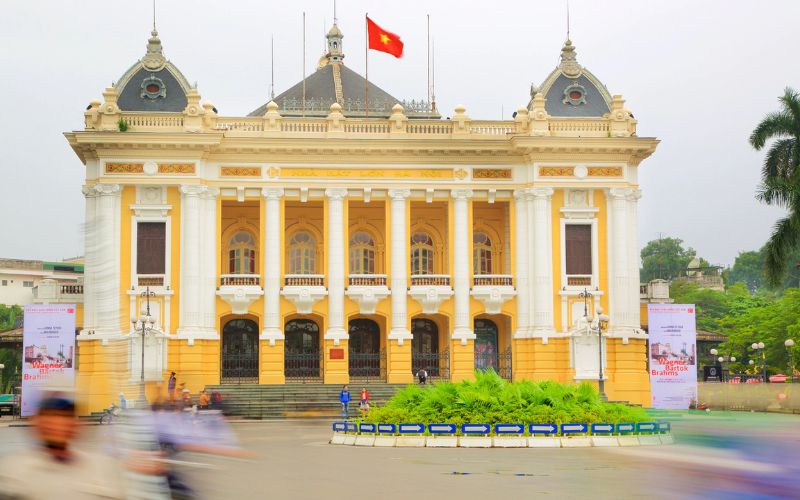
Hanoi Opera House
A visit to the Opera House offers you not only an opportunity to appreciate the iconic architectural features but also provides insights into the unique characteristics of Hanoi’s cultural heritage. Moreover, the Hanoi Opera House hosts a range of captivating concerts and performances. Attending one of these shows allows visitors to immerse themselves in enchanting melodies and artistic performances. Ticket prices for these concerts typically start from 200,000 Vietnamese Dong, offering an accessible opportunity for you to experience the cultural richness of Hanoi.
Hoa Lo Prison Museum
Hoa Lo Prison holds great historical significance. It is a renowned destination in Hanoi that should not be missed. The museum offers a unique experience as it authentically recreates scenes from the past, allowing visitors to gain a deeper understanding of Vietnamese history and the immense struggles endured by the courageous Vietnamese people. The museum’s remarkable exhibits provide a vivid depiction of the harsh realities faced by prisoners during wartime. This immersive experience offers a glimpse into the challenging conditions and the strength of the Vietnamese people in the face of adversity. The entrance fee for both children and adults is reasonably priced at just 30,000 Vietnamese Dong.
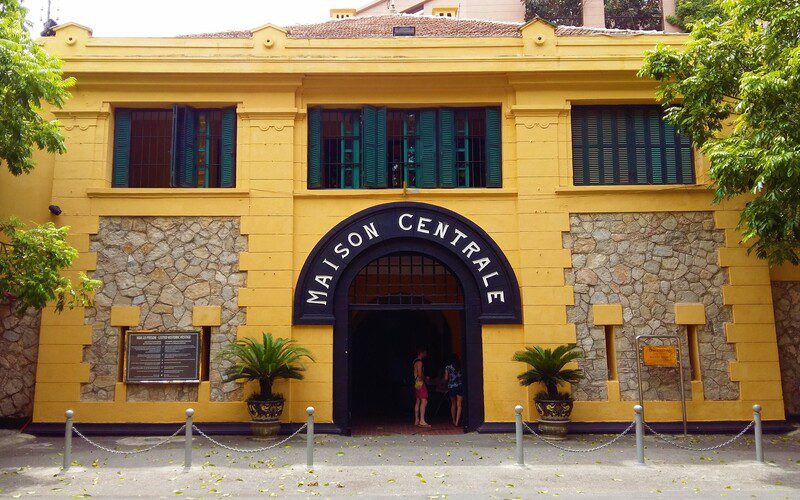
Hoa Lo Prison
Thang Long Art Gallery
Located at 41 Hang Gai in Hanoi’s Old Quarter, Thang Long Art Gallery is a prominent destination for art enthusiasts. This gallery showcases a collection of exquisite and valuable works by Vietnamese artists, offering visitors a deeper understanding of Vietnamese art through its unique and captivating pieces. A visit to Thang Long Art Gallery provides an opportunity to admire an impressive display of high-quality photographs and paintings. For those who find a particular artwork captivating, the gallery offers the option to purchase pieces to bring home. This enables visitors to not only appreciate the art during their visit but also acquire a tangible memento to cherish and enjoy beyond their time in the gallery.
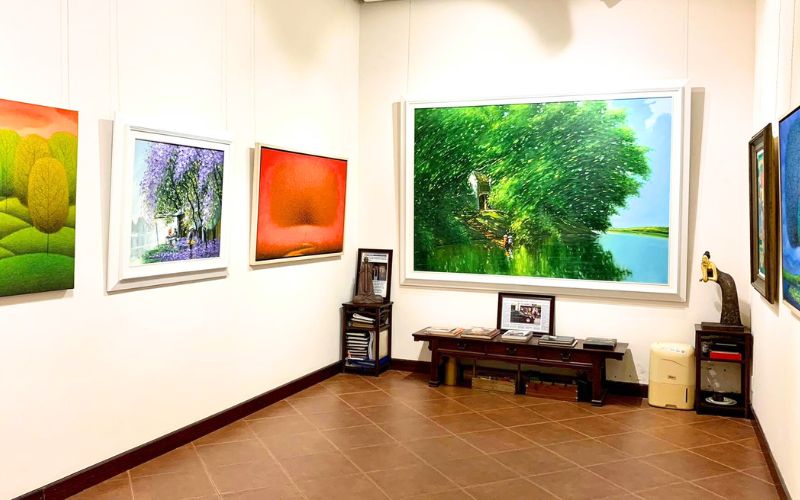
Thang Long Art Gallery
By exploring the Vietnam National Museum of History, visitors can appreciate the remarkable achievements, resilience, and diversity of the Vietnamese people over centuries. It offers a unique opportunity to connect with the past, fostering a deeper appreciation and understanding of Vietnam’s cultural and historical identity. Whether you are a history buff or simply interested in learning more about Vietnam’s fascinating past, a visit to the Vietnam National Museum of History is highly recommended during your trip to Hanoi. If you have any plans to travel to Hanoi or the National Museum of History in the near future, please feel free to contact us. We are here to assist you and provide any information or guidance you may need for your trip.

